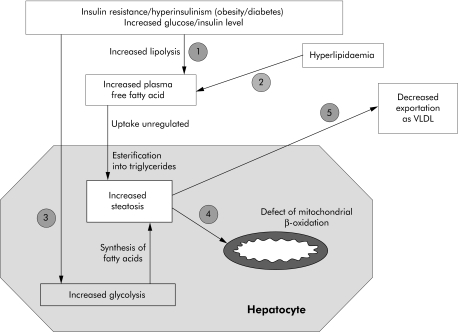Figure 1 Pathophysiology of steatosis. Hepatic fat accumulation occurs when the fatty acid input exceeds the amount that can be either secreted as very low density lipoprotein (VLDL) or oxidised as energy source (output). The main causes of fatty acid accumulation in the liver are numbered below. (1, 2) Increased hepatic uptake of fatty acids. Fatty acids are mobilised from peripheral adipocytes under the action of hormone sensitive lipoprotein lipase. Insulin resistance leads to increased lipolysis with accumulation of circulating fatty acids; this is then followed by increased passive uptake in hepatocytes. (3) Increased glycolysis. Insulin resistance/hyperinsulinaemia stimulates glycolysis with synthesis of fatty acids. (4) Decreased removal of fatty acids due to impaired mitochondrial β‐oxidation. (5) Decreased export of fatty acids secreted from the hepatocyte bound to apolipoprotein B as VLDL.

An official website of the United States government
Here's how you know
Official websites use .gov
A
.gov website belongs to an official
government organization in the United States.
Secure .gov websites use HTTPS
A lock (
) or https:// means you've safely
connected to the .gov website. Share sensitive
information only on official, secure websites.
